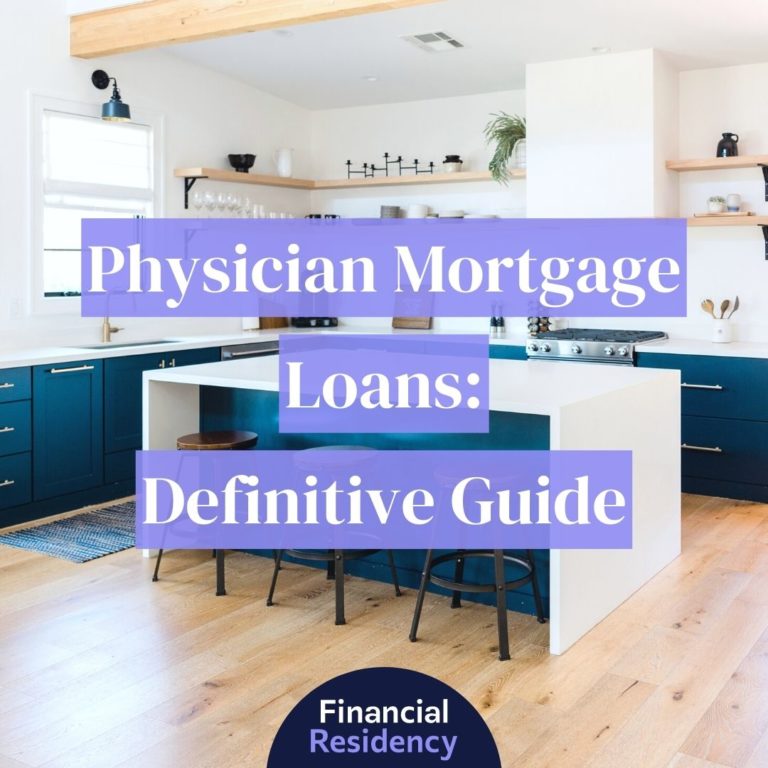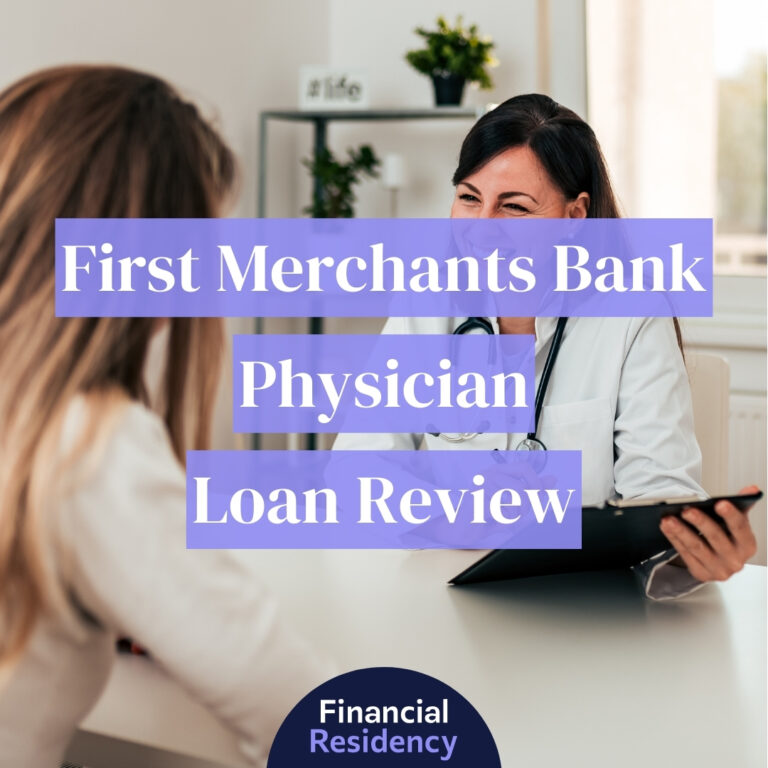Investing in a home can help you build net worth, but qualifying for a mortgage can be challenging for physicians just out of med school unless you have thousands of dollars saved.
The good news is there are options, including physician and conventional loans. The bad news is that they are vastly different mortgage programs that only suit certain borrowers.
Here’s what you should know.
Physician Loan vs. Conventional Loan: Quick Guide
Physician and conventional loans are similar because they help you buy a home. The similarities end there. The down payment, credit score, debt-to-income ratio, and interest rate options differ for each loan.
Here’s how they compare.
What Is a Physician Loan?
A physician loan is for doctors and other medical professionals just out of school. It has more favorable terms because most medical professionals just out of school have a large debt and low income, making it hard to qualify for traditional financing.
Physician loans have more flexible guidelines, making qualifying easier because lenders know the potential physicians have after they complete their residency and fellowship.
New physicians often don’t have the required proof of income or a long enough employment history for conventional loans. Physician loans, however, approve physicians with an employment contract, even if they haven’t begun working.
The most attractive features of physician loans include the following:
- No down payment
- No Private Mortgage Insurance
- Competitive interest rates
- Higher loan amounts
Discover The Best Lenders Answer just a few questions about your career, where you're buying, and how much you want to borrow. Our service will then show you the exact programs you're eligible for from vetted physician loan specialists who will guide you through every step of the process – obligation-free!
What Is a Conventional Loan?
Conventional loans aren’t for a specific group. If you have the qualifying factors, you can secure conventional financing, no matter your profession. Government agencies don’t back conventional loans.
There are several options, including:
- Conforming Loans – Fannie Mae and Freddie Mac back conforming loans for lenders, making it easier for lenders to offer them. Fannie Mae and Freddie Mac require specific guidelines, including loan limits. In 2023 for most areas, the limit is $726,200.
- Jumbo Loans – If a loan amount exceeds the conforming loan limit, it’s a non-conforming or jumbo loan because Fannie Mae and Freddie Mac won’t back them. Individual lenders handle the guidelines, underwriting, and funding. They also keep these loans on their books.
- Non-qualified Mortgages – Borrowers who don’t meet traditional guidelines may qualify for a non-QM loan, such as a bank statement loan. This type of loan verifies income via bank statements instead of paystubs and W-2s.
The most attractive features of conventional loans include the following:
- Low down payment requirements of 3% to 5%
- Competitive interest rates
- PMI can be canceled when you owe less than 80% of the home’s value
Physician Loan vs. Conventional Loan: Qualifications
All loan programs have qualification requirements to ensure borrowers can repay the loan. The requirements vary by loan type. Here’s what to consider.
Physician Loan
To qualify for a physician loan, you must be in the medical profession working as a doctor, dentist, veterinarian, or doctor with another specialty. It’s also open to high-income medical professionals.
To qualify, applicants need great credit, usually in the 720 to 740 range, although this varies by lender. For example, some lenders may allow a lower credit score if you have a large amount of cash reserves or money saved to cover the mortgage payment. Lenders count mortgage reserves by dividing your total assets saved by the mortgage payment. Cash reserves covering 6 to 12 months are usually best.
Most lenders require a 43% or less debt-to-income ratio to qualify for physician loans. But the good news is they don’t include the full student loan debt payment. If they did, most new physicians wouldn’t qualify.
A first-year resident’s average salary is $71,864 and up to $81,224 in the third year. Since most med school graduates have debt of $202,450, it’s easy to see why physicians can’t qualify for conventional loans.
However, lenders only use the modified student loan payment for graduates who enter an Income-Based Repayment Plan, reducing their DTI and making qualifying easier.
Physicians who haven’t started working need only an employment contract with a set start date and salary.
Conventional Loan
There aren’t as many requirements to qualify for a conventional loan because anyone can qualify. Conventional loans have more flexible credit score requirements, allowing borrowers to secure financing.
However, the other requirements are stricter than physician loans, including:
- Larger down payment requirements
- Debt-to-income ratio maximum of 36%, including the full student loan payment
- Loan limits of $726,200 (in 2023)
- Requires proof of income, current and past, not an employment contract
Conventional loan requirements are stricter for a reason. They ensure only qualified borrowers purchase a home.
Even though physicians may have a higher salary, it doesn’t make them more capable of purchasing an expensive home, especially if they have a large amount of student loan debt combined with a low starting salary.
Physician Loan vs. Conventional Loan: Down Payment
A down payment is your investment in the home. It takes the stress off the lender when you have some money invested in the home. Most loan programs offer more competitive interest rates and terms for borrowers who make a larger down payment.
Physician and conventional loans have different down payment requirements.
Physician Loan
Physician loans require a down payment of 0% to 10%, depending on the lender and your qualifying factors. Many new doctors get by without a down payment and purchase homes worth $1 million or more.
Even if you don’t make a down payment or put down 10% or less, you don’t pay Private Mortgage Insurance. This makes the loan more affordable and easier for physicians to qualify for.
Conventional Loan
Conventional loans require a 20% down payment to avoid Private Mortgage insurance. However, you may qualify to put down 3% if it’s your first home or 5% if you’ve owned a home before.
If you put down less than 20%, you’ll pay Private Mortgage Insurance until you pay the mortgage balance down to less than 80% of the home’s value. Depending on the home’s price and your down payment, this could take many years.
Physician Loan vs. Conventional Loan: Interest Rates
Most borrowers are concerned about the interest rates on their loans or the cost of borrowing the money. You pay a percentage of the loan balance until you pay the loan in full. Therefore, the lower the interest rate is, the more affordable your mortgage payments are, and the easier it is to stay on track with your finances.
Physician Loan
Physician loans often have lower interest rates advertised, but there’s a big difference between the type of interest rates on physician loans versus conventional loans.
Physician loans often have adjustable rates. This means the rate remains fixed for a certain period, usually a few years. It then adjusts annually. It’s the adjusting rate that’s risky because you can’t predict what your rate will be.
Adjustable rates are tied to a specific index, and your mortgage rate is tied to that index. So if the index rate increases, so does your mortgage rate, and vice versa. This can make it harder to budget, especially if you’re still within your residency or fellowship when the rate adjusts.
Conventional Loan
Conventional loans usually offer both fixed or adjustable-rate loan options. If you choose a fixed rate, the rate stays the same for the life of the loan. This means you don’t have to worry about your payment changing regarding the principal and interest payments.
If you set up an escrow account to pay your real estate taxes and home insurance, your payment may change if your taxes or insurance payments change.
However, some conventional loan borrowers choose an adjustable-rate loan to take advantage of the lower introductory rate. This works well for borrowers who know they’ll keep the home for a limited time or, in the case of doctors, knowing their income will increase drastically soon makes it easier to accept the potentially higher payments when the rate adjusts.
Physician Loan vs. Conventional Loan: Pros and Cons
All mortgage loans have pros and cons. Understanding the good and bad sides of physician and conventional loans is the key to choosing the right option.
Physician Loans
Physician loans are limited to physicians and other select medical professionals, so that’s a downside for anyone else. Beyond that, here are the pros and cons of physician loans.
Pros
- No or Low Down Payment Requirements – Most borrowers can get a physician loan with no down payment, or if a lender requires one, it’s usually less than 10% on high loan amounts. Your down payment depends on your credit score, loan amount, and lender.
- Higher Loan Limits – Physician loans don’t have the same loan limits as conventional loans. Many physicians borrow money to buy $1 to 2 million dollar homes.
- More Flexibility With Student Loans – Student loan debt usually prevents new physicians from buying a home, but physician loans only include the lower Income-Basd Repayment Plan payment in the debt-to-income ratio, making it easier to qualify.
- No Private Mortgage Insurance – Most loans require some type of mortgage insurance to protect the lender if you put down less than 20% on a home. However, physician loans don’t require any PMI, no matter the loan-to-value ratio.
- You Can Close Before Starting Work – Many lenders allow physicians to close on a physician’s loan with an employment contract as long as they’re due to start working within 90 days.
Cons
- Adjustable Rates Are Common – Many physician loans don’t offer a fixed interest rate. This makes it harder to budget and predict your payments moving forward. If you’re still in the early years of your career, a higher payment could be difficult to afford.
- A Down Payment Isn’t Required – Not needing a down payment may seem beneficial, but it costs you more in the long run. The more money you borrow, the more the loan costs because you’ll pay interest on every dollar you borrow. Making a down payment decreases your loan amount and overall costs.
- You Might Get In Over Your Head – Because of the relaxed physician loan guidelines buying more home than you need or can afford is easy. For example, a $1 million loan may look affordable initially, but it can get difficult once you start making the payments alongside your student debt repayments.
Conventional Loans
Anyone can apply for a conventional loan, including physicians. However, consider some important pros and cons when deciding if they are right for you.
Pros
- Prevents You From Overspending – Conventional loans have stricter qualifying requirements, which you might think is bad, but it prevents you from overspending. If you can’t meet the qualifications to afford the loan, you don’t qualify, which stops you from getting in over your head.
- Competitive Interest Rates – If you can afford a 20% or higher down payment, you can get competitive interest rates and avoid Private Mortgage insurance, keeping your loan costs down while you enjoy homeownership.
- Cash Gifts Are Allowed – If you need money for the down payment, most conventional lenders allow you to use gift funds or money from friends or family for the down payment. Of course, you must follow the lender’s guidelines to prove the funds aren’t a loan, but it’s a great way to get the necessary down payment for a home.
- Anyone Can Apply – You don’t need to be a physician to apply for a conventional loan. You may borrow the funds if you meet the qualifying requirements.
Cons
- Includes Student Loan Debt in Your Debt-To-Income Ratio – Physicians usually have high student loan debt, and conventional loans include the full payment required for standard repayment. However, they don’t use your Income-Based Repayment amount to calculate your DTI, making it harder to qualify.
- You Need a 20% Down Payment to Avoid PMI – PMI adds to your mortgage payment and makes qualifying more difficult. If you don’t have 20% to put down, you’ll pay PMI until you reach an 80% loan-to-value ratio on your loan.
- You Can’t Close Before Starting Work – If you have an employment contract but have yet to start your job, you can’t qualify for a conventional loan. The exact timeline required by lenders varies, but many will require you to be on the job for six months or longer before they consider the income.
Frequently Asked Questions
Choosing between a physican loan and a conventional loan is a big decision. Here are some more questions we get about the loans.
Is taking out a physician loan risky?
Borrowing money is risky, no matter how much money you make. When you borrow money, you promise to repay it. If your income change for the worse or you have unforeseen circumstances, it might be difficult to pay for the loan. Since mortgage loans are secured, you could risk losing your home if you miss too many payments.
What types of physicians qualify for physician home loans?
Most physicians qualify for physician home loans, including specialists, veterinarians, eye doctors, and surgeons. Some physician mortgage loan lenders also offer the program to higher-earning medical professionals that don’t have a doctor title but are in the medical profession.
How do I decide which type of home loan to choose?
Choosing the right home loan depends on your circumstances. For example, if you don’t have money to put down on a home but have the income to afford the payments or at the tail end of your fellowship, you might consider a physician loan. You know you’ll be able to quickly catch up and build equity because your income is about to change.
However, if you have a 20% down payment or aren’t sure when your income will increase, you may want to wait until you qualify for a conventional loan to avoid getting in over your head.
What is the right mortgage length for me?
Your mortgage term or length determines how long you have to pay off the mortgage. The longer the term is, the more interest you pay. Choose the mortgage length that offers a payment you can afford and keeps your interest costs minimal.
Physician Loan vs. Conventional Loan: Which is Best for You?
Look at the big picture when comparing the physician loan vs. conventional loan. They both have pros and cons and suit only certain types of borrowers. The largest risk with physician loans is getting in over your head in debt, but conventional loans are more difficult to obtain.
Shop around, look at the total costs, and consider your future as you determine which loan option is right for you.




